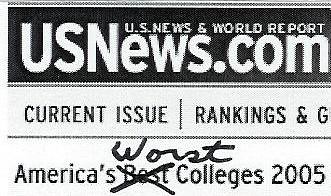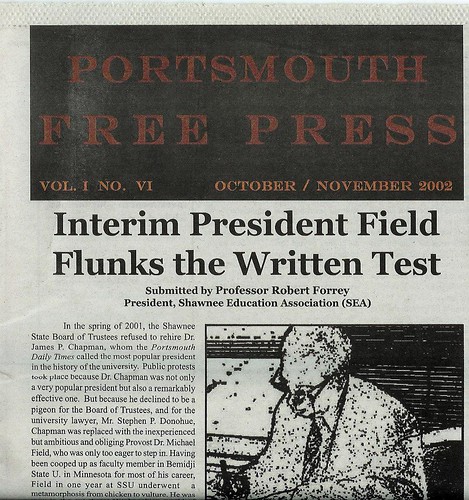The now infamous Marting building
As infamous as it deservedly is, the city’s purchase of the Marting building was not unique. It is part of a pattern in which members of Portsmouth’s heavily abated privileged clique unload distressed property on the public. The public continues to pay long afterwards because the property the elite unloads typically is unsuited for public use because of its condition and its location. Like the Marting and the Kendrick buildings, such properties usually have to be extensively repaired or renovated. The hidden long-range costs of such repairs and renovations are rarely acknowledged at the time the property is unloaded because that would show the folly of purchasing old but architecturally insignificant structures when new ones, designed for the specific uses to which they would be put, would be cheaper and far more efficient in the long run. Count on it – the 100-year-old Marting building will end up costing the public an arm and a leg.
But that is nothing new. It goes on all the time. As an example, let’s review a couple of house purchases by Shawnee State U. On 9 April 2001 SSU agreed to purchase 3060 Camelot Drive, which now houses Shawnee State’s president. As was the case with the Marting building, the public paid far too much for 3060 Camelot ($412,000), which, because of its location and condition and lack of parking space, never should have been bought in the first place, at any price.
3060 Camelot. Note truck, materials, and crack in driveway
Since it was not his own but the public’s money he was spending, there was little motivation for George Clayton, the Shawnee State trustee who brokered the deal for 3060 Camelot, to bargain with the doctor who owned it. Clayton could afford to be generous to a neighbor on the Hill, and he was. In a flat real estate market and for a prematurely old house that the departing doctor was having trouble selling, Clayton agreed to pay a whopping purchase price. And that was just the beginning.
In 2001, the Portsmouth architectural firm of Tanner Stone made an inspection of 3060 Camelot for the trustees and declared it sound. The Tanner Stone report concluded, “it must be said this is a truly fine house. It appears that it was well built and, possibly more importantly, has been well maintained.” The Tanner Stone conclusion was, to put it mildly, misleading. But Clayton got what he wanted, an endorsement of his decision to purchase 3060 Camelot, just as the Marting Foundation got from Ken Rase the high appraisal it wanted to unload the Marting building at an inflated price.
From top to bottom and in between, 3060 Camelot was a lemon. Let’s start at the top, with the cedar-shingled roof. The contractor who had previously done sealing work on the roof claimed, according to the Tanner Stone report, that if the roof continued to be resealed every three years, it could last for ten or more years. At such time in the future when the roof might need to be replaced, it could be done for as little as $10,000 the same contractor claimed, according to the Tanner Stone report.
Let us now fast forward, not fifteen, not ten, but to just a couple of years, and what we discover is that the roof on 3060 Camelot had to be replaced. The cost was not $10,000, not $15,000, but $30,000! And there were additional costs connected with the roof. There were drains, which cost $2,618, and gutters:, which cost $466.
How about the middle of the house, the living area? According to the Tanner Stone report the house had been well maintained, but I was at a trustees’ meeting at which it was reported that newly appointed president Rita Rice Morris on her first tour of the house had found the main living area in sore need of repainting and re-papering. The cost was $7,590. And of course the house had to be furnished. The cost for the furniture was $15,000. The university had previously purchased furniture for a temporary presidential house, but that furniture was reportedly not the right style for 3060 Camelot. I will get back to that temporary president’s house later.
In SSU files that I viewed under Ohio’s open records law, I found a long list of items that needed to be repaired or replaced at 3060 Camelot. Just repairing the shower, for example, cost $1,659. There is a hot tub on the rear porch, and keeping that up is no small expense. Servicing it cost $803 and a new cover for it $463. There was $2,406 for leaks around fans, etc. There were thousands of dollars in other costs to add to the $412,000. The point is there are immediate expenses with an older house that would not have been the case with a new one.
Now let’s look at the foundation of 3060 Camelot, which is located on a hill. The ground on which 3060 Camelot is located has proved somewhat unstable. In building 3060 Camelot in 1980, the contractor had apparently used fill to provide an even foundation for the house, which was also the case in 1990, when another garage was added. What struck me when I first drove several miles up to 3060 Camelot about five years ago were the large cracks in the asphalt in front of the house. Those cracks may or may not have any relationship to a potential problem that Tanner Stone acknowledged in their report: the garage that had been added and an adjoining retaining wall needed to be shored up to prevent them sliding down the hill. The approximate cost for securing the garage and wall was $15,000 - $20,000, according to Tanner Stone. The doctor claimed that work could be done for a fraction of that figure, which he promised to do before the sale. But is it only the garage and wall that are unstable? Will 3060 ever settle down?
The most surprising thing I saw in the files I obtained were the costs connected with maintaining and improving the grounds around 3060. One item in the file revealed the cost of tree and stump removal: $9,250. And there are many thousands of dollars more listed, including $3,150 for (presumably) another tree removal and $1,645 for landscaping. Perhaps the house and grounds had been well maintained, as Tanner Stone reported. But if that is the case then even well-maintained houses only 20 years old can be money pits.
What makes this all the more hard to take is that the trustees had previously committed to building a new presidential house on or near the campus. The trustees had authorized the creation of a President’s House Committee, of which I was a member and of which George Clayton was chairman, to plan for that house. Two things that the committee agreed upon early on was that “the house must be in close proximity to SSU’s campus” (7 Jan. 1999), and that it should not be a “Shawnee brick” square box house. Susan Warsaw, a member of the committee, urged us to “think outside box.” Instead of hiring the usual architectural suspect, Tanner Stone, the committee selected a young Columbus architect, Michael Hasara, and the committee encouraged him to be creative. He came up with an original design that the committee approved, but George Clayton and William McKinley, another member of the committee, early on began criticizing the design and undermining the architect. (For a view of Hasara’s extraordinary work, in both traditional and modern styles, explore his website at www.hasara.com) And to see what might have been, look at the proposed design for SSU. It was to be built on the southeast corner of Waller and Second St., where a parking lot was built instead.
After the committee had chosen a site on campus and was preparing for the groundbreaking, and the university had already paid Hasara about $10,000 of his fee, George Clayton picked a fight with the young architect and accused him of refusing to make changes in the design that he Clayton had asked for. I don’t know what these changes were, because Clayton was using the House Committee as a front and rubber stamp for himself and the trustees. Hasara told others at SSU via email that Clayton was misrepresenting the situation. When he learned about Hasara’s email, Clayton did his Don Corleone imitation. Loyalty is what Clayton expects above all from others, even though he seems congenitally incapable of it himself. I knew Hasara only slightly, but I got to know Clayton well enough to know whose word I would believe.
Hasara was fired and the commitment to build a house in close proximity to the SSU campus was scuttled. And what better place was there for a new president to live than on the Hill, not far from George Clayton and other trustees? And why waste money building a new house anywhere when there was a deserving doctor on the Hill with a house on his hands?
I now suspect that one of the reasons Hasara was terminated and the plans for the presidential house on campus were scuttled was that several influential trustees had concluded that in hiring James P. Chapman as president they had made a mistake. Chapman was too close to the faculty, among whom he had tremendous support – the most popular president the university had ever had, the Daily Times reported editorially. The trustees had never been able to get along with the faculty, and would be suspicious of any president who did. The trustees preferred a president like Clive Veri, however incompetent and unpopular with the faculty he may have been, because Veri knew how the game was played. For one thing, he lived in a home up on the Hill. The trustees decided to locate the president’s house and the new president that they would get to replace Chapman a good distance – physically and symbolically – from the campus, even though such a decision went in the face of what the trustees had publicly committed themselves to.
According to the minutes of t the trustees’ meeting at which they approved the purchase of former trustee Jo Ann Thatcher’s 1828 Franklin Boulevard house, the chairman of the trustees, Frank Waller “stated that this [Thatcher’s house] was an interim home and that sometime in the future, a presidential home would be built close to or on campus. Mr. [George L.] Davis voiced his approval of the resolution even though he had no vote at this meeting, stating that it shows a commitment to build a presidential home on campus.” Actually all that this palaver about building a presidential house on campus showed was how far some trustees would go to create a smokescreen to cover up the obvious conflict of interest they had in buying a former trustee’s house as an interim house at an inflated price of $230,000. When the university tried to sell the Thatcher house, it had no takers at this fraudulent figure. After being on the market for an embarrassingly long time, 1828 Franklin was sold not for $230,000 but for $180,000, the tax-payers taking a $50,000 loss, along with the thousands of dollars spent on it in the interim.
There is a possibility that in purchasing 1828 Franklin and 3060 Camelot SSU may have violated state law, which forbids the state paying more than 10% above the appraised value of property. I’ve been told the Thatcher house was appraised at $200,000 (and that may have been one of those suspiciously high appraisals that take place when a property of the clique goes on the market), so in paying 15% more for it, SSU appears to have gone over the 10% limit. The Thatchers reportedly got a twelfth hour offer that led trustee chairman Frank Waller to increase SSU’s offer. That incidentally, also is what happened at 3060 Camelot. At the twelfth hour the selling price was jacked up because the doctor claimed he had a higher offer from another party. Even if that offer was made, should it change the appraised value of a house? Does all this sound fishier than something cooked up in Johnson’s Restaurant? Surely, if there was anything illegal or unethical, SSU counsel Stephen P. Donohue, who is rumored to be an Ohio Assistant Attorney General and who has gone on to become a part-time judge, would have been on it like Gangbusters.
If 1828 Franklin and 3060 Camelot were money pits, Martings could turn out to be Scioto's great cesspool. Estimates for Marting’s renovation have ranged from 2 to 10 million dollars. Most tax-payers in Portsmouth could tell you which of those two figures will be closer to the eventual cost. Through public feeding tubes and other means, public monies will pour into the hundred year-old building for the next quarter of a century. “I know every stinking inch of that building,” a former employee of Marting’s said recently at a public meeting. What is the source of that stink? If the physical foundation of 3060 Camelot is somewhat mushy, the moral foundation of the Marting building is even more so. Located as it is in the heart of Portsmouth’s downtown red light district, the illegitimate offspring of a phony Foundation and a corrupt city council, Marting’s is just up the street and around the corner from the law offices of George Clayton’s cousin.



